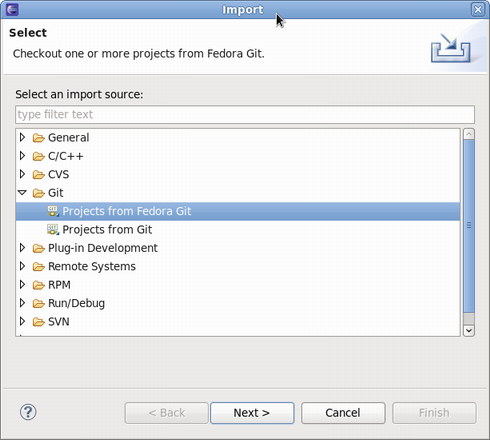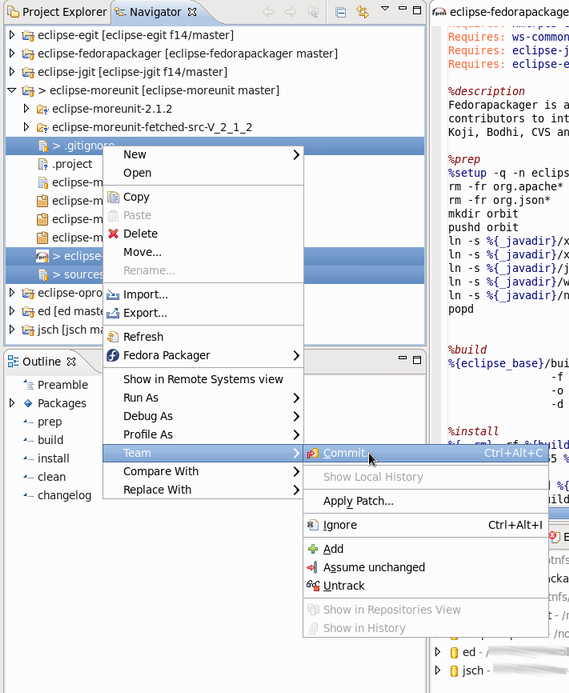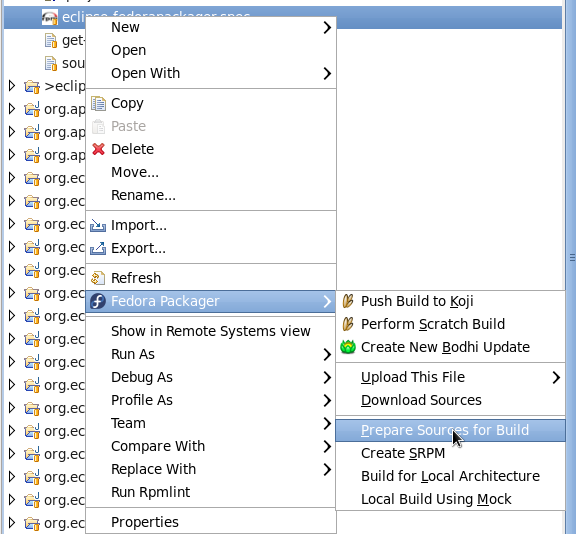m (Oturpe moved page User:Mziaei1/eclipse/How to maintain old to Archive:Mziaei1/eclipse/How to maintain old: Does not seem relevant any more) |
m (Oturpe moved page Archive:Mziaei1/eclipse/How to maintain old to User:Mziaei1/eclipse/How to maintain old over redirect: Revert previous move, it did not accomplish what I intended) |
(No difference)
| |
Revision as of 19:55, 2 October 2021
How to Maintain Fedora Package
So, you have decided to become a package maintainer in the Fedora Project? This guide will lead you through your first package submission.
Creating Account
If you are a new package maintainer:
Creating a new account on Fedora Account System
just testing the sub page test new page
- First step is to create account on Fedora Account System (FAS).
- Click New account and fill in the blanks.
- After you create your account, please be sure to sign the CLA (if you click on the My Account link in the top right, you should see CLA: CLA Done).
- Also you need to upload a public RSA SSH key. You need to use the matching private key to access Fedora machines via SSH.
- Here is information on creating SSH key.
Creating a Bugzilla Account
Create an account on Red Hat bugzilla.
- The email address that you use for your bugzilla account should be the same email address as you use in the Fedora Account System for all things related to fedora packaging.
- Do not use your
@fedoraproject.orgaddress in bugzilla, because you will not get your bugzilla privileges once you are sponsored.
- If you want to use your
@fedoraproject.orgaddress, you might try to request at the Fedora Infrastructure Ticket System for an administrator to manually override the bugzilla address connected with your fedora account.
Installing the client tools
- 1. You need to generate a client side certificate at the Fedora Account System and save the file in
~/.fedora.cert, where fedpkg will look for it by default.
yum install fedora-packager
- Then run the following command and simply follow the instructions provided:
fedora-packager-setup
- 2. To build Packages for the Fedora Collection or EPEL, you also need Koji. You can now use koji to try to build your RPM packages on platforms (e.g. PPC) or distributions you don't have. Note that you can test out builds ("scratch" builds) even when your package hasn't been approved and you don't have a sponsor.
- Here is a simple way to do a scratch build using koji on the command line. Check more information on this koji syntax.
koji build --arch-override=PLATFORM --scratch TARGET path_to_source_RPM
Making a Package
Packaging Guidlines
- If you don't know how to create a RPM package, refer to the tutorial at A Short RPM Tutorial or the more advanced and much more detailed how to create an RPM package.
- Make sure it is a new package. Check this list of existing packages.
- Make sure it is a suitable package. Read Packaging Guidelines and Packaging Naming Guidelines.
- Read some other package submissions to learn about packaging and gain familiarity with the process and requirements. One way of doing this is to join the
package-review@lists.fedoraproject.orgmailing list.
Creating an RPM package:
Follow the following steps to create a RPM package:
- 1. Select File > New > Other... from the main menu. Choose RPM > RPM Project, click Next.
- 2. Type the Project name. Click Finish.
- 3. Right click on SPECS, select New > Other..., choose RPM > Specfile Based on a Template, click Next.
- 4. Fill out the template or accept the default values and customize it based your package specifications.
- You can also use RPM-stubby plug-in to create a spec-file stub (for Eclipse feature or maven project).
- 5. When your package is ready to submit for review, select File > Export from the main munu, choose RPM > Source/Binary RPM, click Next.
- 6. Based on your requirements, select one or both options, click Finish.
- This user guide has more information on working with specfile-editor in Eclipse.
Submiting For Review
Joining the Mailing Lists
When a new package maintainer joins the Fedora Project, we request that he/she introduces themselves on the devel@lists.fedoraproject.org. To sign up for the list, visit the devel list signup page.
- The primary purpose of this is to begin the process of building trust by learning about the package maintainer and increase the chances of your review request being processed sooner.
- The purpose of all this is to break anonymity and foster real-world community within the project. You are under no obligation to reveal personal secrets. The objective is to establish a level of trust with yourself and the other members of the project.
- Subject: Self Introduction
- Body: Add any information you believe is applicable including past experience, a link to the review request you have filed and a brief description of yourself. You can also post your GPG key information if you want to.
- Here is the information of possible mailing lists for you to join. And there is also a list of.
Uploading the Package
Upload your SRPM and SPEC files onto the Internet somewhere. This can be anywhere accessible by a URL.
- If you need hosting space, please make a note of it in your ticket submission and someone will take care of you.
- If you have already got a Fedora Account then you can use your storage at
<user-name>.fedorapeople.orgfor this.
Creating Review Request
Before submitting your request, be sure there is not a previous request for the same package.
- Fill out this form at bugzilla.
- Make sure that you put the name of the package (excluding version and release numbers) in the Review Summary field, along with a very brief summary of what the package is.
- Put a description of your package (usually, this can be the same thing as what you put in the spec
%description) in the Review Description field. - Include the URLs to your SRPM and SPEC files.
- If this is your first package, explain it and say that you need a sponsor.
Bugzilla feedback
- You should get notifications of changes by email. Fix any blockers that the reviewer(s) point out.
Ready to Ship
Follow these steps after your package is approved by reviewers.
Obtaining Member Sponsorship
After your package is approved by reviewers, you must separately obtain member sponsorship to check in and build your package.
- Sponsorship is not automatic and may require that you further participate in other ways in order to demonstrate your understanding of the packaging guidelines.
- Key to becoming sponsored is to convince an existing sponsor-level member that you understand and follow the project's guidelines and processes.
- See how to get sponsored into the packager group for more information.
Requesting a new package SCM
When the package is approved by the reviewer, request a git module and branches with the Source Code Management(SCM) admin requests.
- Mention the name of the branches you need your package to be included in.
Checking Out the Empty Module from SCM
Once you have the git module, checkout your module from git.
- Select import > Git > Projects from Fedora Git and click Next.
- type the name of the package in Package name.
- It is probably a good idea to make a "git" toplevel directory, then check-out your files inside of that. Refer to this user guide on Using Fedora Git for more information.
Updating the SCM
Importing and Committing the Package Contents
After you checked out your empty git module, you need to import and commit your package contents into the master branch.
- 1. Right-click on your
src.rpmfile in SRPMS folder on your local RPM project in eclipse, click Copy. - 2. Right-click on your cloned project from Fedora Git, click Paste.
- 3. To upload this file, right-click on it, select Fedora Packager > Upload this File > Add to Existing Sources. This either adds the file to the sources required to build the package or replaces the current content of the sources file to contain a single line with the MD5 sum of the file selected.
- 4. Do the steps 1-3 for your
.specfile in SPECS folder. - 5. To commit the package contents to the git repository, select the files to commit (alternatively select the Fedora Git project and select desired unstaged files when the commit dialog is shown), right-click, Team > Commit...
- Use this message for your initial commit: "
Initial import (#nnnnnn)" (where nnnnnn is your Bugzilla package review bug number).
Building the Package
Preparing Sources for Local Build
Eclipse Fedora Packager will download and prepare sources for building a package.
- Select your spec-file, right-click, Fedora Packager > Prepare for local build.
Building RPM for a Local Architecture
This is a great way to test if the spec-file actually builds at all. Once the RPM has been successfully built locally, it is recommended further testing be carried out on the spec-file by completing a build in a chroot'ed environment using mock. Both ways are supported by Eclipse Fedora Packager.
- To build the RPM locally right-click on the spec-file Fedora Packager > Build for Local Architecture. Output of the RPM build will appear on the Eclipse console.
Using mock-builds is a great way to test the Requires/BuildRequires of a spec-file.
- To build the RPM locally using mock-build, right-click on the spec-file Fedora Packager > Local Build Using Mock. Be aware that this may take a long time (>20 minutes) and requires the mock package to be installed. Use Eclipse's Run in Background functionality for convenience.
Submiting Package as Update in Bodhi
If this package will be built for any version of Fedora that is already released, please submit it for inclusion in the fedora-updates repository for those versions of Fedora. For doing this:
- Switch to the appropriate git branch on Git Repositories view.
- Right click on your project, Fedora Packager > Create New Bodhi Update.
Closing the Bugzilla Ticket
- If the package built successfully, you should close it as NEXTRELEASE.
Enabling Upstream Release Monitoring
Fedora has infrastructure available for monitoring new upstream releases of the software you are packaging.
- Refer to Upstream Release Monitoring for more details.
- Learn to handle updates by reading the Package update HOWTO.
Updating Your Package
Once you have pushed your package into the git repository, you can follow these instructions on Fedora Packaging in Eclipse to modify your package contents and push them for koji build.




